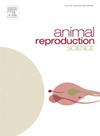Increasing piglet weaning age while maintaining the reproductive efficiency of the breeding herd depends on being able to stimulate sows to ovulate during lactation without reducing subsequent pregnancy rates and litter sizes. Embryo survival is affected by the quality of the oocytes shed at ovulation, and oocyte quality is profoundly impacted by the follicular environment in which the oocyte matures. This study determined the effect of reducing suckled litter size from 11 to 7 piglets on day 18 of lactation on the ovarian follicular environment and oocyte developmental competence at day 21 of lactation. Thirty-nine, Large White X Landrace sows (parity 3.2 ± 0.2; mean ± SEM; range 2–6) had their litter size either maintained at 11 piglets (control); or reduced to seven piglets on day 18 of lactation (split wean (SW)). Sows were slaughtered on day 21 of lactation and ovaries were collected for analysis of follicular fluid composition and in vitro blastocyst development rates. There was no effect of split weaning on fertilisation rate and development to blastocyst stage; however, a greater proportion of blastocysts from control sows were classified as early blastocyst stage. Furthermore, follicular fluid concentrations of oestradiol were higher in SW sows. Together, these results indicate split weaning prior to mating in lactation alters the ovarian follicular environment and while blastocyst development rates were unaffected, embryos from control sows may be of poorer quality as indicated by a delay in development.


